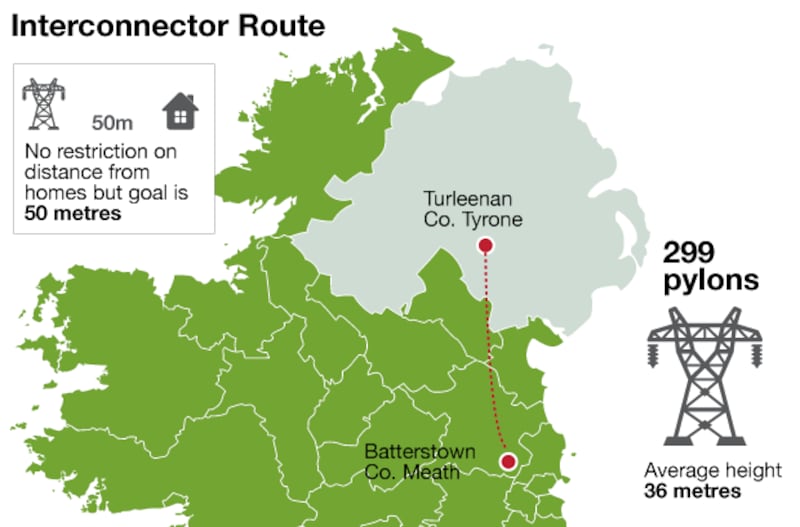Opponents of a controversial 140km high power electricity link-up from Co Meath to Co Tyrone have vowed to fight on after planners gave it the green light.
EirGrid has secured permission for the North-South Interconnector running on 299 pylons about 50m high from a substation in Woodland, Co Meath to Clontibret in Co Monaghan.
A separate planning application for the Northern Ireland section of the cross-border network, running to Turleenan, Co Tyrone, is expected to be ruled on next year.

Padraig O’Reilly, of the North East Pylon Pressure group, said the campaigners, plus landowners and farmers along the route, expect to challenge the decision in the courts and seek cross-party support from politicians to force EirGrid to consider burying the 400 kilovolt lines.
“It’s very likely that we will take a judicial review,” he said. “From a political perspective, we are demanding that there’s a shift to underground. We believe that there is a larger number of politicians now in the Dáil who are in favour of undergrounding.”
Mr O’Reilly also claimed Minister for Natural Resources Denis Naughten could order EirGrid to come up with an alternative.
The North-South line is part of EirGrid’s national project to secure supplies and modernise the transmission system in projects that could cost anything from €2.7 billion to €3.9 billion depending on the choices made on the voltage lines.
There will be 409 pylons on this line in total, including the Northern Ireland section. Up to 250 farmers and landowners between Dunboyne and Carrickmacross back the group, with one woman living about 20m from the proposed high-voltage line, 75 homes within 100 meters of the lines and 150 within 200 meters.
Fund
It is claimed that landowners were being offered €22,000 for every pylon on their property. A separate fund being run by EirGrid offers grants of 5,000 to €30,000 for community projects for towns and villages along the route. The North East Pylon Pressure group said a devaluation survey found that the project would wipe 350m euro of the value of homes, land and other properties along the line.
Fintan Slye, chief executive of EirGrid, said the North South Interconnector is “undoubtedly the most important infrastructure scheme on the island”. “(It) will also provide local benefit for the people of the north east by strengthening the electricity network in the region; a catalyst for inward investment and job creation,” he said.
“The project will also increase capacity of the grids north and south, helping to facilitate the connection of more renewable electricity generation. This is essential to achieve sustainable energy targets set by the EU.”
The Northern Ireland element of the cross border project is to go to a public inquiry in February. EirGrid said the interconnector will improve the security of electricity supply across the island of Ireland, improve efficiency, reduce costs and save customers’ money.
It also claimed to have taken the views and concerns of landowners on board and made several amendments to the proposed route. Thomas Cooney, the Irish Farmers’ Association environment and rural affairs chairman, said the decision ignored the substantial concerns of the communities.
“From the beginning, EirGrid did not support the proposal to underground this project and it seems as if they have achieved their desired outcome today,” he said. “However, communities are now left in a position where, by and large, their concerns have been rejected by An Bord Pleanala.”
Approved plan
An Bord Pleanala approved the plan, citing it as the most cost-effective solution.In the north, the Safe Electricity Armagh and Tyrone (SEAT) group said underground cables were the responsible and efficient alternative.
“SEAT completely understands the need for a better energy supply and the importance of a reliable service for Northern Ireland, but it must be safe,” it said.
“We want to make it clear that SEAT is not opposing the interconnector itself. We, along with all the landowners and affected residents on the proposed route, are however vehemently opposed to the use of a dangerous very high voltage overhead interconnector.”
PA












